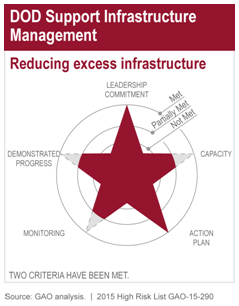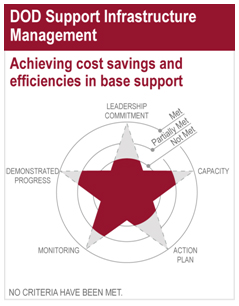Surplus DOD Real Estate and Infrastructure
 BRAC is DOD’s primary way to reduce excess infrastructure. However, the most recent round that started in 2005 and was completed in 2010 reduced only a small portion of DOD excess, and cost more than initially estimated. Further, more than half of the excess facilities in fiscal year 2010 were long-standing excess—some sites have not been needed since the 1960s.
DOD has made progress in this area, closing 57 major bases in the previous BRAC rounds (1995 and 2005) and reporting in fiscal year 2013 an additional net reduction of 7.7 million square feet through other efforts, but inaccurate data and other problems may hamper future efforts.
BRAC is DOD’s primary way to reduce excess infrastructure. However, the most recent round that started in 2005 and was completed in 2010 reduced only a small portion of DOD excess, and cost more than initially estimated. Further, more than half of the excess facilities in fiscal year 2010 were long-standing excess—some sites have not been needed since the 1960s.
DOD has made progress in this area, closing 57 major bases in the previous BRAC rounds (1995 and 2005) and reporting in fiscal year 2013 an additional net reduction of 7.7 million square feet through other efforts, but inaccurate data and other problems may hamper future efforts.
 The second strategy for achieving efficiencies in DOD real estate involves consolidating support services—everything from environmental preservation to snow removal—for joint bases, separate bases run by different branches of the military that were combined because they are near to each other.
In 2012, we found that joint bases reported meeting common standards for consolidated functions more than 70 percent of the time in fiscal years 2010 and 2011. And in 2014, we found that the joint bases reported partially consolidating 80 percent of their functions.
However, as shown in our star rating, DOD has made less progress in this area than in reducing excess infrastructure. We’ve outlined multiple steps the department can take to improve, for example, by providing clear directions to its bases that include goals and time frames.
Excess Property=Excess Spending
As we continue to find in our reviews, DOD must better manage its real estate and get rid of facilities it no longer needs. If it does, the money it spends to maintain those unneeded facilities could be used on other priorities or eliminated from DOD’s budget.
Interested in more? Check out our full High Risk page, with videos and other materials.
The second strategy for achieving efficiencies in DOD real estate involves consolidating support services—everything from environmental preservation to snow removal—for joint bases, separate bases run by different branches of the military that were combined because they are near to each other.
In 2012, we found that joint bases reported meeting common standards for consolidated functions more than 70 percent of the time in fiscal years 2010 and 2011. And in 2014, we found that the joint bases reported partially consolidating 80 percent of their functions.
However, as shown in our star rating, DOD has made less progress in this area than in reducing excess infrastructure. We’ve outlined multiple steps the department can take to improve, for example, by providing clear directions to its bases that include goals and time frames.
Excess Property=Excess Spending
As we continue to find in our reviews, DOD must better manage its real estate and get rid of facilities it no longer needs. If it does, the money it spends to maintain those unneeded facilities could be used on other priorities or eliminated from DOD’s budget.
Interested in more? Check out our full High Risk page, with videos and other materials.
- Questions on the content of this post? Contact Brian Lepore at LeporeB@gao.gov.
- Comments on GAO’s WatchBlog? Contact blog@gao.gov.

GAO's mission is to provide Congress with fact-based, nonpartisan information that can help improve federal government performance and ensure accountability for the benefit of the American people. GAO launched its WatchBlog in January, 2014, as part of its continuing effort to reach its audiences—Congress and the American people—where they are currently looking for information.
The blog format allows GAO to provide a little more context about its work than it can offer on its other social media platforms. Posts will tie GAO work to current events and the news; show how GAO’s work is affecting agencies or legislation; highlight reports, testimonies, and issue areas where GAO does work; and provide information about GAO itself, among other things.
Please send any feedback on GAO's WatchBlog to blog@gao.gov.
